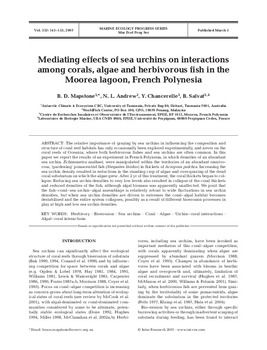Mediating effects of sea urchins on interactions among coral, algae and herbivorous fish in the lagoon at Moorea, French Polynesia.

Citation
Mapstone, B.D. et al. (2007). Mediating effects of sea urchins on interactions among coral, algae and herbivorous fish in the lagoon at Moorea, French Polynesia.. Marine Ecology Progress Series, 332:143-153
The relative importance of grazing by sea urchins in influencing the composition and structure of coral reef habitats has only occasionally been explored experimentally, and never on the coral reefs of Oceania, where both herbivorous fishes and sea urchins are often common. In this paper we report the results of an experiment in French Polynesia, in which densities of an abundant sea urchin, Echinometra mathaei, were manipulated within the territories of an abundant omnivorous, ‘gardening’ pomacentrid fish (Stegastes lividus) in thickets of Acropora pulchra. Increasing the sea urchin density resulted in reductions in the standing crop of algae and over-grazing of the dead coral substratum on which the algae grew. After 2 yr of this treatment, the coral thickets began to collapse. Reducing sea urchin densities to very low levels also resulted in collapse of the coral thickets and reduced densities of the fish, although algal biomass was apparently unaffected. We posit that the fish–coral–sea urchin–algal assemblage is relatively robust to wide fluctuations in sea urchin densities, but when sea urchin densities are driven to extremes the coral–algal habitat becomes destabilised and the entire system collapses, possibly as a result of different bioerosion processes in play at high and low sea urchin densities.
Permalink
Date Available
Type
Publisher
ISSN
0171-8630
Topics
Language